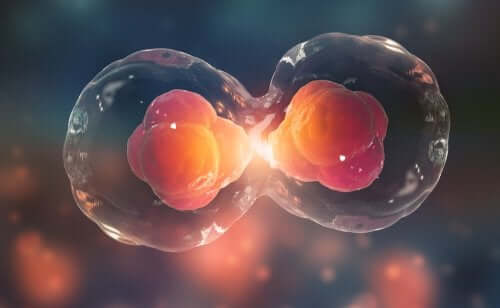Building Blocks of Life: The Cell Cycle

In this article on genetics and the building blocks of life, we’ll try to explain the mechanism of cell reproduction. In fact, one of the tasks of cells is to multiply and perpetuate cell lines. Additionally, we’ll talk about the cell cycle because, at the end of the process, the cell must return to the starting point again.
We know that genetic material collects in the cell nucleus. How and when this information is transmitted is what cell biology researches. It’s not only responsible for analyzing the phases that take place during cell reproduction, but also the alterations or mutations that occur during the development of this process.
But what exactly is the cell cycle?
Genetics for children: definition of the cell cycle
Essentially, the cell cycle is the orderly series of processes that lead to the renewal of cells. In other words, it’s the ability of the cells to reproduce and produce two copies that are the same as the original.
During the cell cycle, a series of phases takes place in two stages: one that we call the interphase (non-division state) and the other which is Phase M (division state). The process begins at the moment when, after reproduction, a new cell forms. It then culminates when it gives rise to two daughter cells.
What is the interface?
This is the period during which the cell prepares to duplicate itself. To do this, it must copy its genetic material. This means that it must have twice as many chromosomes in order to be able to transmit a complete set to each daughter cell.
This phase is divided into 3 stages: G0 / G1, S and G2
- G0 / G1 is the initial stage. The cell begins to synthesize RNA and proteins, and to duplicate its organelles, specifically the centrosome. At this point it will have doubled in both mass and size. At the end of this phase, there’s a point of no return, “restriction point R”, and the interface can no longer be stopped.
- Phase S is the preparation for mitosis. At this point, the cell replicates its DNA, as well as the chromosomal proteins, the histones. However, there is still no cell division.
- During the G2 phase, everything has to be ready to enter the division phase. It’s preceded by a lapse in which the cell cycle control mechanisms ensure that the duplication of DNA has been done correctly. The synthesis of RNA and proteins continues and begins to destabilize the nuclear membrane and to form a structure called an “achromatic spindle.”
At this time, the cell is ready to move on to the next stage: Phase M.
The cell cycle: Phase M
As we were saying, M is the stage in which the cell division itself occurs. It can be mitosis, if it gives rise to two daughter cells the same as the progenitor. If it’s meiosis, however, it gives rise to 4 germ cells.
The choice between these processes will determine the end of the cell cycle. Basically, this M phase includes two stages: mitosis and cytokinesis.
Mitosis
During this phase, there are a series of characteristics which we can highlight:
- The division of the nucleus and the subsequent distribution of the chromosomes between the two daughter cells.
- It’s a continuous process divided into 4 periods: prophase, metaphase, anaphase and telophase.
- It guarantees the conservation of hereditary material during the equal distribution of chromosomes.
- At the end of the stage, the two resulting cells are genetically identical to each other and the mother cell.
Cytokinesis
The cell cycle culminates with the physical division of the cytoplasm between the two daughter cells, with cytokinesis. This stage overlaps with the anaphase, and the division of the nucleus and the cytoplasm occur practically at the same time.
In animal cells this process is carried out by strangulation of the equatorial area of the mother cell. On the other hand, in plant cells a separation septum called phragmoplast forms, and this divides the original cell into two units.
What happens if the cell opts for the meiosis route?
In fact, this process only takes place when the organism is interested in generating germ cells. These cells have half as many chromosomes as a normal cell in the body, since they’re the cells involved in reproduction.
Obviously, meiosis is more complex than mitosis. But we can define it as two mitoses one after the other, in order to obtain 4 daughter cells. These are different from the mother cell, since each one has half the number of chromosomes.
The importance of this process lies in the first meiotic division. In it, the homologous chromosomes cross each other in such a way that the result is slightly different from those of the original cell. In this way, nature introduces, at random, variations in the genes that, theoretically, allow us to evolve.
“I have called these individually favorable variations and differences and the destruction of those that are harmful, natural selection, or survival of the fittest.”
–C. Darwin–
We hope that this article about the cell cycle has been interesting and has helped you think about how you can explain this concept to your children.
All cited sources were thoroughly reviewed by our team to ensure their quality, reliability, currency, and validity. The bibliography of this article was considered reliable and of academic or scientific accuracy.
- Pérea Porto, J y Gardei, A. (2017). Definición del ciclo celular [artículo en web]. Recuperado de: www.definicion.de
- Alberts, B. Biología molecular de la célula. Edición: Omega